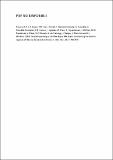Por favor, use este identificador para citar o enlazar a este item:
http://hdl.handle.net/10261/319887COMPARTIR / EXPORTAR:
 SHARE
BASE SHARE
BASE
|
|
| Visualizar otros formatos: MARC | Dublin Core | RDF | ORE | MODS | METS | DIDL | DATACITE | |

| Título: | Coastal upwelling in the Rías Bajas, NW Spain: Contrasting the benthic regimes of Rías de Arosa and de Muros |
Autor: | Tenore, K.R.; Boyer, L.F.; Cal, Rosa; Corral-Estrada, Jerónimo; García-Fernández, Cristina CSIC ORCID; González-García-Estrada, Nicolás; González-Gurriarán, Eduardo; Hanson, R.B.; Iglesias-Estévez, José; Krom, M.D.; López-Jamar-Martínez, Eduardo; McClain, J.; Pamatmat, M.; Pérez-del-Pozo, Alfonso; Rhoads, D.C.; Santiago-Fierro, Guillermo de; Tietjen, J.H.; Westrich, J,; Windom, H.L. | Palabras clave: | Medio Marino upwelling Sede Central IEO Galician Rias mussel rafts organic enrichment |
Fecha de publicación: | 1982 | Citación: | Journal of Marine Research, 40, 3. 1982: 701-772 | Resumen: | Nutrient-rich North Atlantic water upwells off the NW coast of Spain and intermittently intrudes into the rias, coastal embayments, by displacement during periods of offshore winds. High primary production associated with the upwelling supports an intensive raft culture of the edible mussel, M y tilus edulis. This culture is most intensive (ca. 2000 rafts) in the Ria de Arosa, and results in one of the highest protein yields per unit area on earth. Mussel feces, in tum, serve as food for other species of epifauna which live on, or between the densely-packed mussels. These epifauna, in tum, serve as food for demersal fish and crabs. The epifauna mineralize a great deal of the mussel feces but still there is high deposition of organic-rich deposits to the seafloor, where they are utilized by a low diversity benthic assemblage dominated by the polychaete Spiochaetopterus costarum and comesomatid nematodes. Sedimentary structures, profiles of pore-water constituents, and C/ N and 210Pb vertical profiles show that sediment deposits under the rafts are mixed to a depth of about 20 cm. Bioturbation is a relatively unimportant advective process in Ria de Arosa sediments, and mixing is apparently accomplished by bottom current erosion. Mixing may take place with a frequency of less than one month, releasing pore water ammonium and phosphate into the water column and replenishing pore water sulphate. The Ria de Muros, an embayment north of the Ria de Arosa, has few (< 100) mussel rafts. The benthos in muddy sediments of the Muros consists of a high diversity, equilibrium assemblage dominated by a subsurface deposit-feeding polychaete (Maldane glebifex), an ophiuroid (Amphiura chiajei), a holothurian (Leptosynapta bergensis) and desmodorid nematodes. Bioturbation is an important mixing process in Muros sediments. This biogenic process is reflected in high rates of pore-water exchange and mixed vertical profiles of Pb | Versión del editor: | https://images.peabody.yale.edu/publications/jmr/jmr40-03-08.pdf | URI: | http://hdl.handle.net/10261/319887 | ISSN: | 0022-2402 |
| Aparece en las colecciones: | (IEO) Artículos |
Ficheros en este ítem:
| Fichero | Descripción | Tamaño | Formato | |
|---|---|---|---|---|
| JMR.pdf | 70,74 kB | Adobe PDF |  Visualizar/Abrir |
CORE Recommender
Este item está licenciado bajo una Licencia Creative Commons

